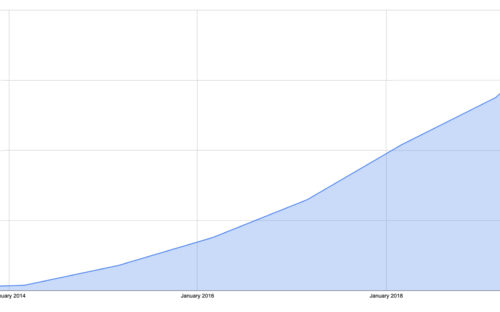

“I am limited by the technology of my time, but one day you’ll figure this out. And when you do, you will change the world.” – Howard Stark
Technology and humanity have always had an interesting relationship.
Technology has given us some of the greatest discoveries of our time. It’s given us cures for diseases. It’s given us the ability to connect with millions around the world. It’s given us the ability to improve longevity. And it’s given us the ability to understand our world in new ways.
All this being true…
Emerging technologies are still something that many people believe threatens our well-being and will lead to our demise. This view isn’t a new one. Luddites in the 19th century destroyed textile machinery because of the threat associated with an increased use of mechanized looms and knitting frames.
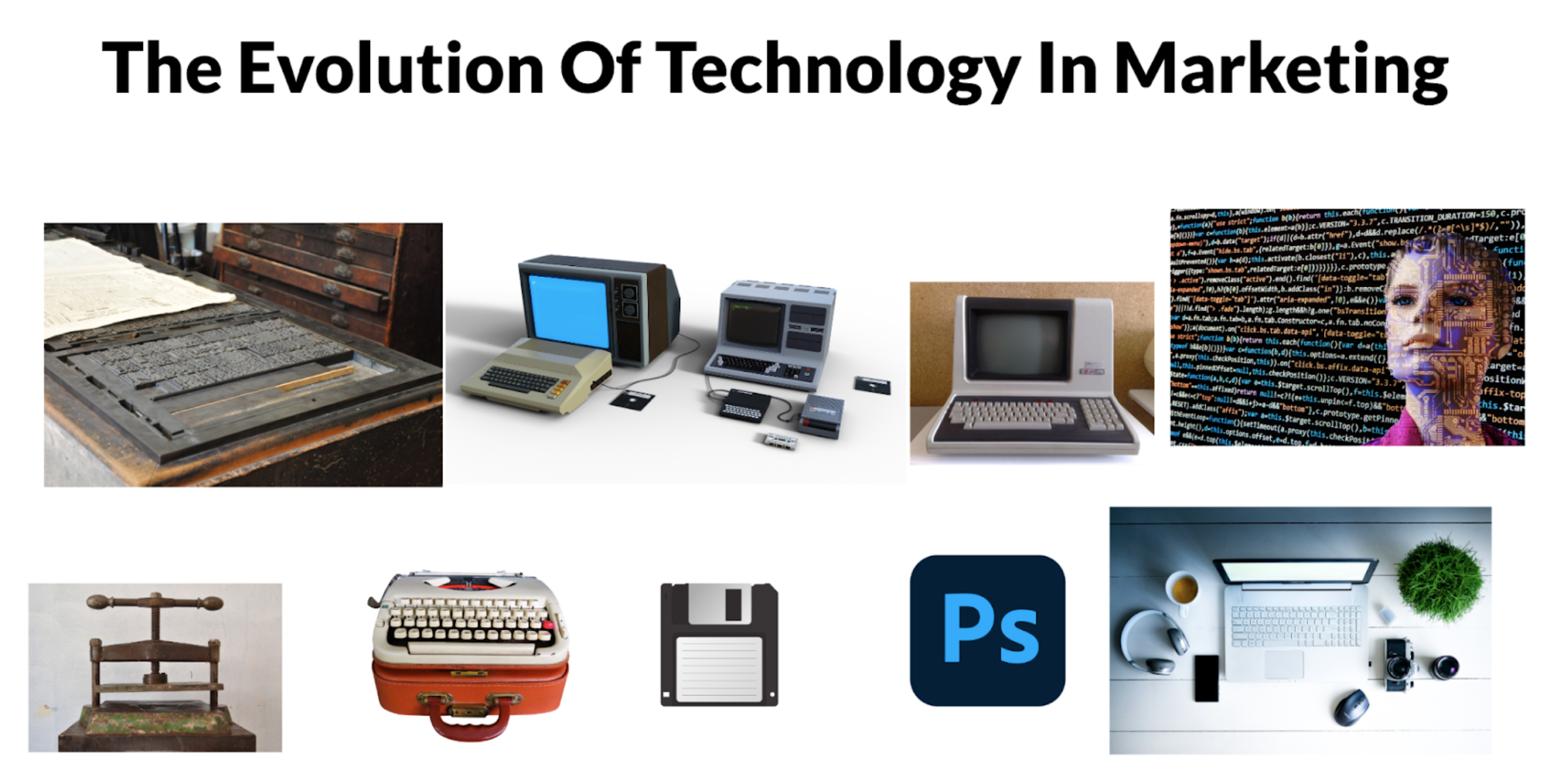

The world of marketing has seen tremendous evolution thanks to technology.
I remember my first months working at an ad agency, and chatting with one of the VPs about their work. They explained to me how they ran the print and film arm of the business, using a dark room to produce photos and a printing press for brochures. It was mind-blowing — because by then, Photoshop or iMovie could do exactly what he was describing.
He “retired” a few months later.
Today, we live in a world where beautiful designs can be created with nothing more than a laptop. Just 40 years ago, you needed ink pads, grid paper, scissors, rulers, rubber cement, and so much more. Today, we live in a world where you can run an advertisement that reaches hundreds of people in New York City — from your basement in Halifax, Nova Scotia. Today, you can write an article on a laptop, and that article is distributed through social media channels and reaches thousands.
The evolution of technology in marketing has been amazing to witness.
But more change is coming, and this time, it’s going to shake up more than just graphic designers and video teams within the industry. The latest technological shift, artificial intelligence, is going to impact everything.
In December 2022, it was reported that Alphabet (owner of Google) issued a “code red” over the rise of the AI bot ChatGPT. Since then, speculation has been at an all-time high amongst marketers about how ChatGPT and other AI technologies could impact the way we search for information online — and what it all means for Alphabet’s business.
Billions of people use Google’s search engine every single day, and many of those people spend money every single day to capture clicks from Alphabet’s subsidiaries. If ChatGPT and AI tools have triggered a “code red” for this business — it should be triggering a code red for every other technology-based industry.
In the remainder of this article, I’m going to share some of my thoughts on how artificial intelligence is going to influence the marketing industry in the coming years, and what brands, marketers and advertisers can do to prepare for what is to come.
Let’s get into it.
Will Artificial Intelligence Replace Marketers?
The emergence of artificial intelligence (AI) has already transformed the marketing industry, impacting how and when brands can reach their target audiences, but you may not realize it.
If you’ve run Google ads or Facebook Ads over the last 5 years, it’s likely that an AI has been involved in determining your target audience or budget allocation. In the early days of these ad products, a PPC expert would have used a spreadsheet to manage it all. But now you can simply click a button, and the optimizations are done for you by the platforms.
This hasn’t replaced PPC marketers. And I don’t think it will replace them any time soon.
But it certainly has changed the role they play when it comes to running campaigns.
More and more tasks are going to be eradicated because of artificial intelligence.
With AI, marketers now have access to powerful tools that allow them to better understand consumer needs, create graphics within seconds, create long-form posts within minutes, generate AI scripts, and automate mundane tasks. The role of marketers will never completely evaporate from the ecosystem, but the things that make up their work are certain to change.
Photographs & Illustrations Can Be Created Using AI
At the top of this blog post, you saw an image that resembles Don Draper. Don Draper (portrayed by the actor Jon Hamm) was the main character in the popular TV series Mad Men, which showcased the life of an advertising executive in the ‘60s. In the visual above, he takes on the look of someone who is part human and part robot. This is because I wanted to communicate the idea that artificial intelligence will not replace us as humans, but instead augment us.
Here are a few early versions of the graphic that almost made the cut:
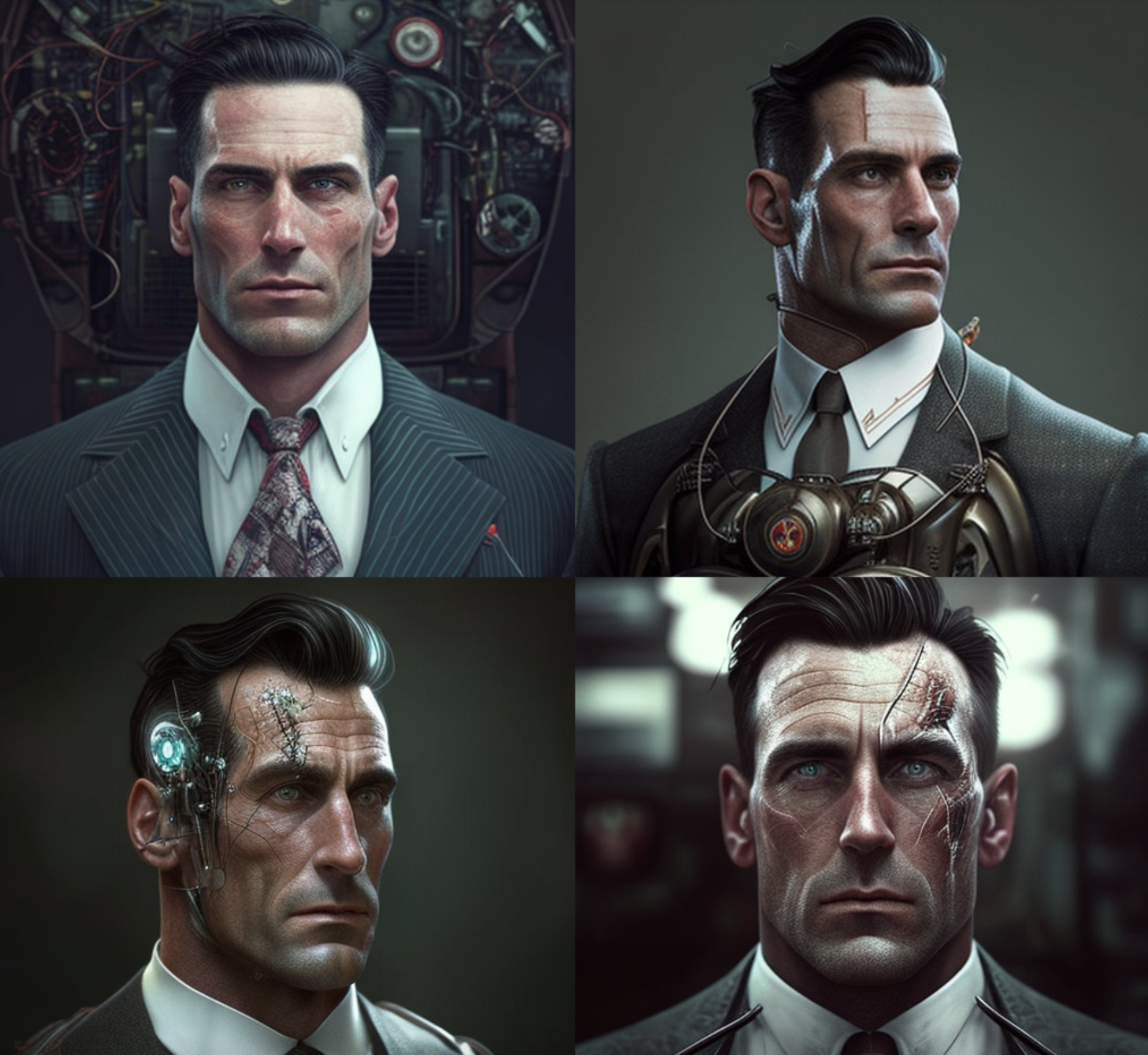

All pretty good, right?
What if I told you that these were all created via artificial intelligence, with a tool called MidJourney?
All I had to do was ask MidJourney to create a realistic version of Don Draper as part robot or cyborg, and within seconds, I had a selection of images to choose from.
No illustrators. No designers. No artists.
Just an AI tool and a prompt.
This is powerful for many reasons. At scale, you could use an AI tool like Midjourney, Freepik AI, or Wepik to develop multiple images for your blog posts without having to pay thousands of dollars to stock photo websites to source a valuable graphic. An AI tool could even play a role in the development of an advertisement and save you money on design, photography, and more.
Let’s take this advertisement from 2020 that was named one of the best:
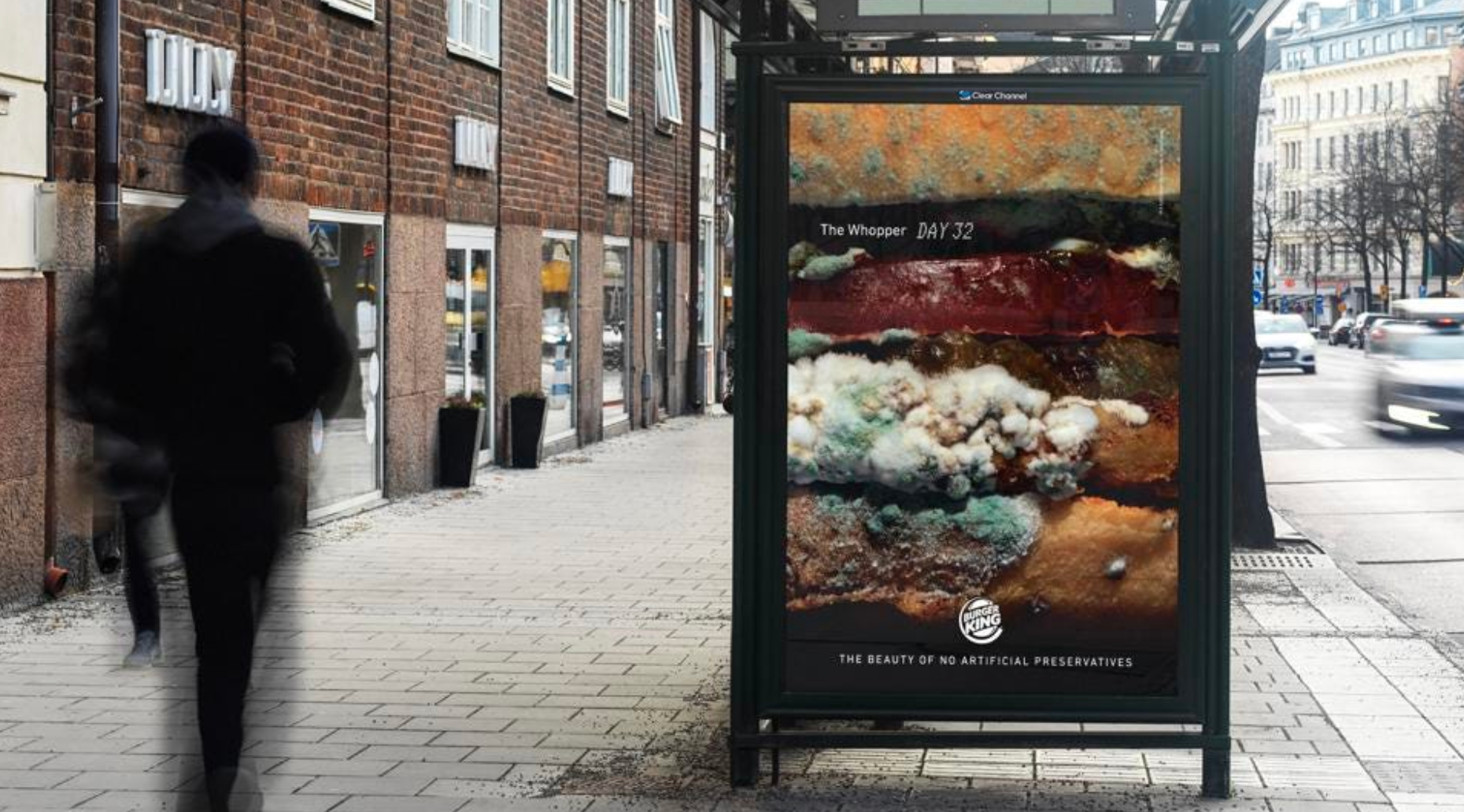

It’s a clever ad, right? It won tons of awards.
But capturing the photo for this might not have been easy.
Thanks to Midjourney, though, I can create a picture of a moldy burger within seconds:
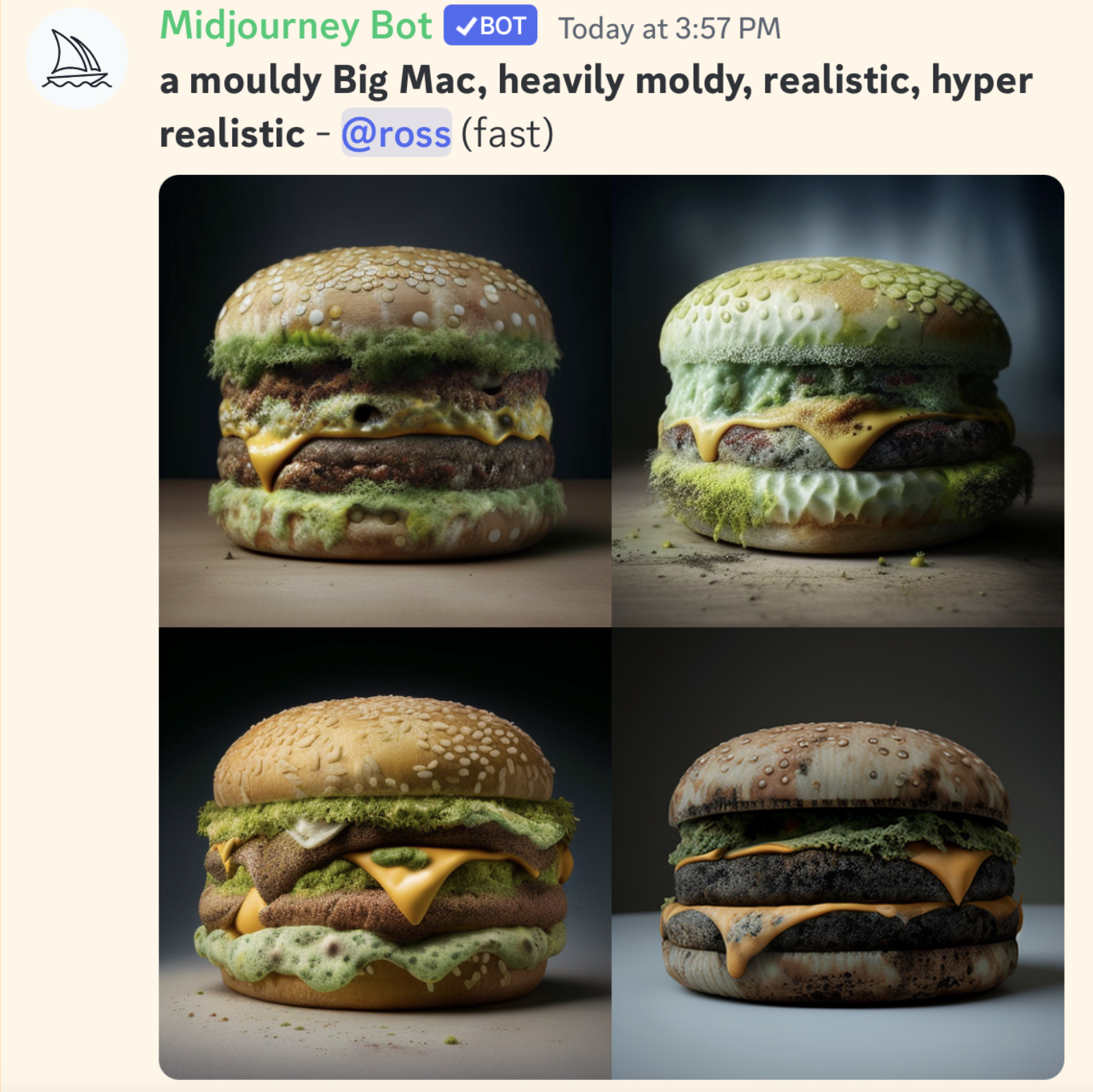

Not bad eh?
With these images of a moldy burger, I can prompt MidJourney to touch up the one that I like the most.
Given these options, I think the top right burger has the most realistic look and feel, so I can prompt the tool to give me a few alternatives. In seconds, I’m provided with four different options to choose from:


Now, I can take this burger over to Photoshop and create a new version of the Burger King ad in minutes:


To remove the background, I used an AI tool called “Remove BG,” which automatically detects and gets rid of any unwanted background imagery.
Sure, the result Isn’t exactly like the original ad:
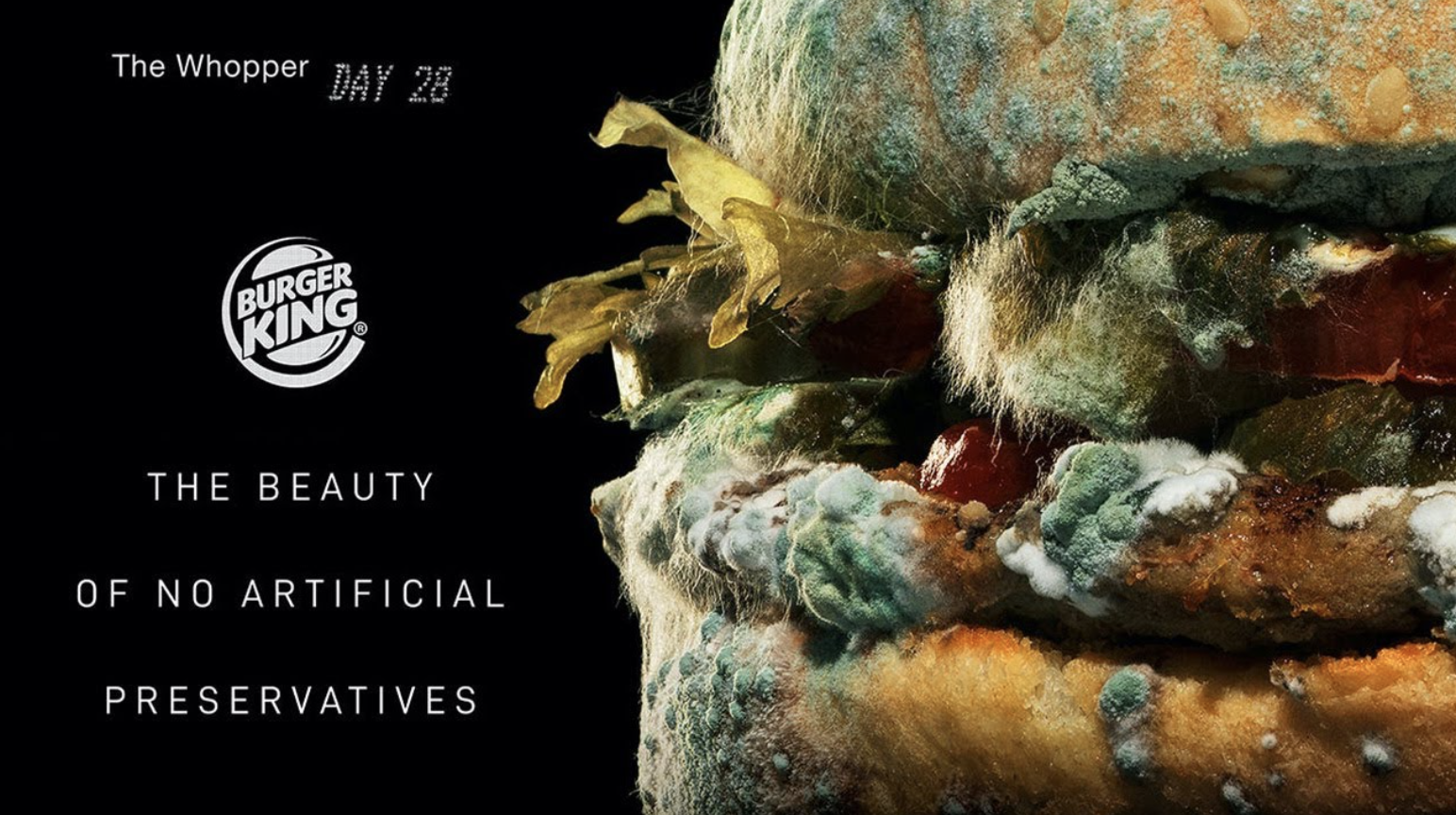

But it’s not too bad for 5 minutes of work.
We’re not there yet, but in the future, I envision a world where we will be able to tell an AI to create an ad (using a very descriptive prompt) and in response, get an output that matches exactly what we envision in our minds. For example, I asked for a Pizza Hut ad featuring Serena Williams, and a Tylenol ad featuring Donald Glover.
In seconds, using MidJourney, I got these results:


The AI has the ability to understand what goes into an advertisement, what different layouts of an advertisement might look like — and even determine that a Tylenol ad might be more likely to connect with an audience if the person in the ad is wearing a robe.
Are there issues with these ads?
Of course. For example, the text is Lorem Ipsum. It doesn’t make sense. But imagine for a second that these visuals were accessible inside of a tool like Canva, and the Lorem Ipsum areas were editable.
You could create hundreds of variations within an hour and find the layouts that suit your needs best. You could connect with Donald and Serena’s legal and management teams and cut them a check. You could run these ads, and within less than a day, you could launch a campaign that currently competes with most generic advertisements in the consumer goods category right now.
Apart from image creation, AI can also help with image moderation which can check the quality and appropriateness of images to better align with your audience.
How Digital Ad Creation Will Be Changed By Artificial Intelligence
Digital advertising is rapidly changing as artificial intelligence is being integrated into processes. AI can create ads at scale and optimize ad creatives in mere moments. There is already AI-driven ad-tracking software that optimizes your campaigns for the best performance. It can run A/B tests with hundreds of different words, all while writing actual ad copy and making adjustments based on data. The future for digital advertising is a lot less manual.
Digital ad creation is a task that takes only seconds for AI, when it often takes days for humans to perform the same work. As another example, I can now log into a tool like AdCreative.ai and tell it a little about Foundation. In less than 10 minutes, I can use this tool to give me 90+ variations of ads that can be used on LinkedIn, Facebook, Google, and more:


The tool even goes so far as to give an ad a “conversion score” based on its own data.
Once I create a series of different graphics, and confirm that they fit my brand’s aesthetic, I can start to work on the copy. One of my favorite AI copywriting tools is Jasper. You can use Jasper to write everything from blog posts to ad copy for use on Facebook.
Here’s how it works:
I visit Jasper and select that I’m looking to create ad headlines for Facebook:
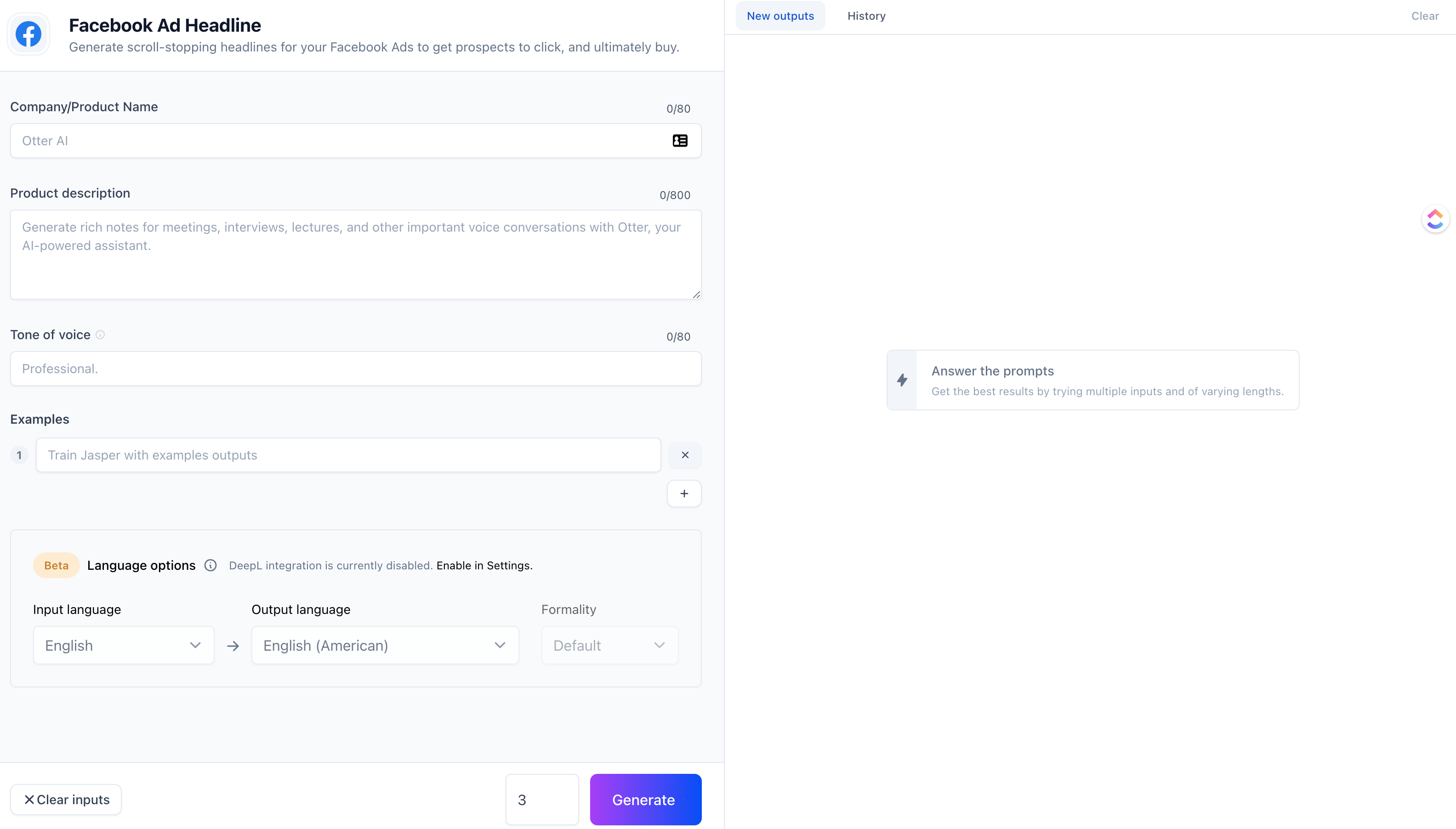

Then, I can provide some details about Foundation that will help Jasper write a headline:


Once this is uploaded, Jasper provides me with a handful of potential headlines in seconds:
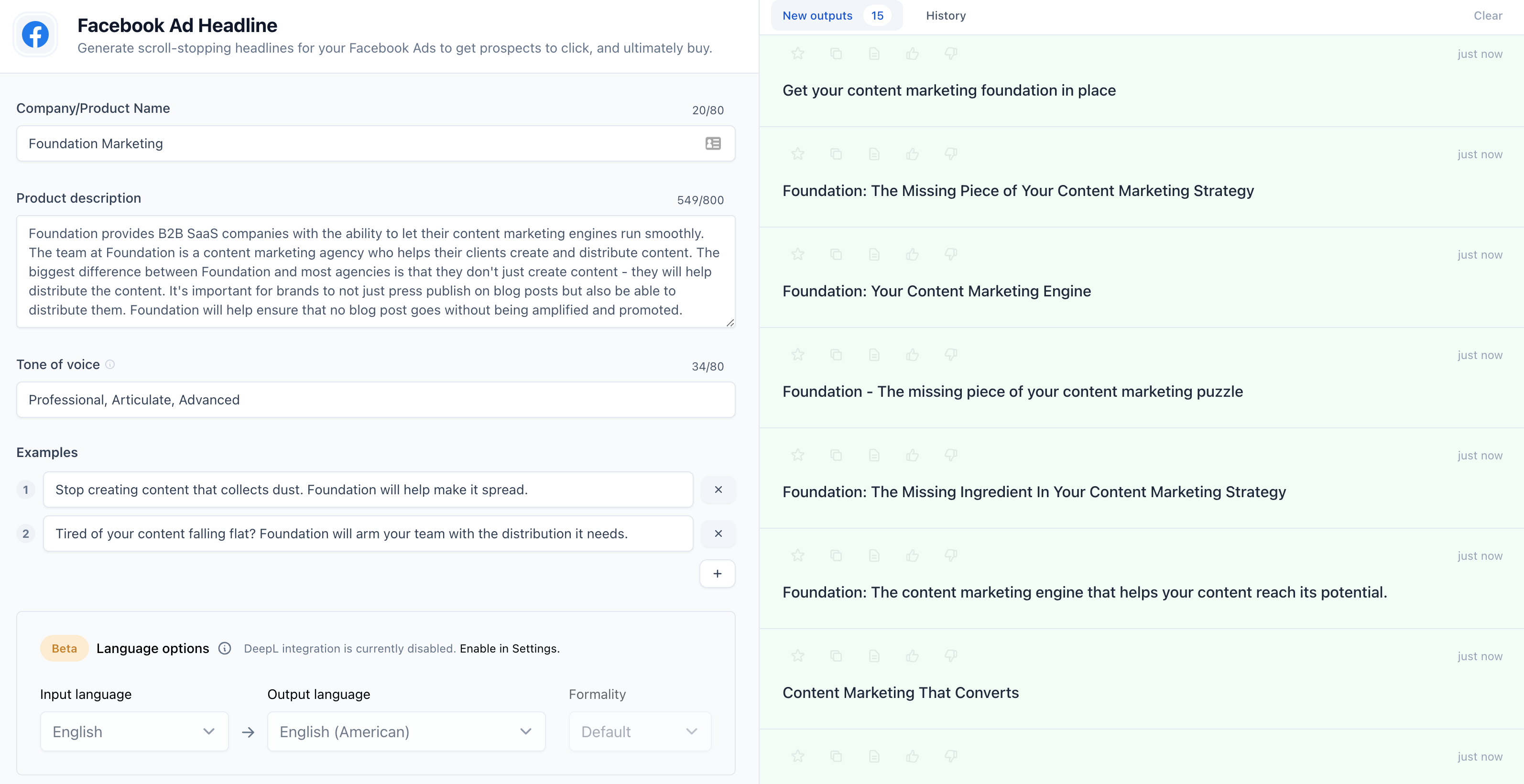

Not bad, right?
I can then go to the “Facebook Ad Primary Text” section of Jasper to generate the ad copy:


And there you have it.
Jasper created Facebook ads that can start running immediately.
HEADLINE:
Foundation: Your Content Marketing Engine
BODY:
Are you ready to get your content seen by more people?
If you’ve been struggling to get your content seen by the right people, Foundation can help. We’re experts at distributing content so it reaches its full potential. And we’ve helped hundreds of B2B SaaS companies just like yours.
Click here to learn more about how we can help you get your content seen by more people and attract more leads, sales, and customers.
Not bad eh?
This is what’s possible using an AI copywriting tool like Jasper.
I’m a huge fan of what their team is building, and I’m giving away 10,000 bonus credits to anyone who signs up using this link. If you’re working in content marketing and have been sleeping on the power of AI copywriting tools, I get it. I was in your shoes.
But I’m convinced that this is the future.
Repetitive Tasks Will Be Automated At Scale
As marketers, we are used to doing a lot of the same tasks, day in and day out. But with the rise of artificial intelligence, many of those tasks will soon be replaced by machines.
One task that will soon be fully replaced by AI is meta description writing. Marketers will no longer have to spend time writing short blurbs that describe their content — instead, tools like Jasper and ChatGPT will be able to do it for them, and better.
This isn’t a prediction.
This is reality today.
You can use an AI tool right now to create a meta description for any blog post that you have on your site. Jasper offers four different types of meta descriptions and titles that it can produce for you, for Blog Posts, Homepages, Product pages and Service Pages.


Let’s say I needed a meta description for this piece.
The one you’re reading right now.
I simply go to Jasper, add the title of the piece, and paste the introduction paragraph into the “blog post description” section. In seconds, I have three different meta descriptions:


The process described above is still somewhat manual, but as tools like Jasper and ChatGPT continue to roll out their own APIs, the ability to customize these outputs at scale will become even more interesting. I recently came across a new Google Sheet product from Arielle Phoenix that breaks down how to combine artificial intelligence and programmatic SEO to create content in bulk. I bought the Masterclass and product as soon as I saw it.
Let me give you a rundown of what it can do:
- Add keywords to a spreadsheet
- The spreadsheet grabs the keywords to create URL slugs
- The spreadsheet runs the keywords against a ChatGPT3 prompt to write SEO-driven meta descriptions and click-friendly blog post titles
- The spreadsheet then uses the title of the blog post to create an introduction
- Next, the spreadsheet uses the title of the blog post to write an outline
- …and so much more.
You can create HUNDREDS of pieces of content within a matter of minutes using the Bulk Publishing Framework + AI-Integrated Google Sheet.
As an example, I wanted to see what the Google Sheet could do, so I decided to list a few keywords that are relevant to the marketing industry. Let’s say Foundation wanted to create definition content on topics like content marketing, editorial calendar, and digital marketing for a marketing blog. I simply add these keywords to the Google Sheet that Arielle Phoenix developed. And using an API connected to ChatGPT, it delivers the title, meta description, intro, outline and more:


This was all developed in the matter of seconds.
Brilliant, right?
It does even more than this, but that’s a blog post for another day.
No more writing meta descriptions. No more writing outlines.
The AI can do it for you. But that’s not all an AI can do.
How AI Accelerates The Content Creation Process
As content marketers, we know that the ability to produce quality content quickly and efficiently is crucial to our success. And while some may be hesitant to embrace artificial intelligence solutions, those who do will be left far behind their counterparts who embrace AI.
Artificial intelligence can help speed up the research process, the briefing process, and even the actual content creation process required to develop a piece of content that is likely to rank in Google. Embracing artificial intelligence can bring immense benefits to content marketers, allowing them to become more productive and produce superior content in a fraction of the time it would traditionally take. So, if you’re still on the fence about AI, let’s revisit the earlier example mentioned—the definition blog post called “What Is Content Marketing.”
Using Jasper, I can take each part of the “outline” that was delivered in the AI Integrated Google Sheet and then place it into Jasper to create a more in-depth blog post. In this case, I simply type “Definition of Content Marketing” into Jasper’s One-Shot Blog Post feature — and within seconds, I have an in-depth breakdown of content marketing:


Let me say this — I wouldn’t publish this verbatim.
But I would pass this along to an expert and ask them to update it so that it sounds more human, has an expert’s perspective, and is reviewed for quality assurance. Using this process, I’m able to improve the quality of the blog post and still produce a piece of content faster than a counterpart who is not using artificial intelligence to create content.
Our workflows are going to change as AI technology continues to advance. The speed in which we navigate through the content creation process should accelerate rapidly in the coming years. And the workflow of the future will be built on the back of AI tools that make the writing process 10x more effective, efficient, and data-driven.
The content creation workflow before AI vs. content creation workflows using AI can be summarized in the following graphic:


In both Content Creation Workflow 1.0 and 2.0, human research is needed to ensure that you’re creating the right things. AI will support the research, but research done by humans is still an important part of the puzzle, no matter whether you embrace the traditional method of content creation or the new method.
In Content Creation Workflow 1.0, the second and third step are both manually completed. The second step in the first workflow is the act of identifying (brainstorming) headlines that should be written for a blog based on a keyword. In the future, this won’t be necessary because you can ask an AI tool to give you 5 headlines based on a keyword, and have those headlines in seconds:


A copywriter might take 30-60 minutes to come up with these 10 blog post ideas.
It took ChatGPT less than 30 seconds.
In content creation workflow 1.0, the next step would be to identify a title and begin working on the framework that makes up the piece. In this case, if we were to write an outline for the title “The Surprising Health Benefits of Nose Breathing and Mouth Taping” it might take a writer and/or researcher anywhere from 1 – 2 hours to complete the task.
An AI tool like Chat GPT, however, can pull the outline within a matter of seconds:


Now that the outline is developed, the next step is simple:
Write the rest of the piece.
The traditional content creation process would take hours (maybe 5-10 per piece), even for an advanced writer. Using AI, the key points in the outline of this piece can be submitted to Jasper, and within minutes, you can have a fully written blog post, breaking down everything there is to know about the basic benefits of nose breathing and mouth taping.
And on the subject of blog posts, a common task for content creators is writing HTML to elevate blog posts. Leveraging ChatGPT, you can ask the service to develop HTML on your behalf. For example, you can ask ChatGPT to develop a chart that compares mouth breathing and nose breathing.
In seconds, you’re met with a chart that is ready to be uploaded to your traditional or headless CMS, and that breaks down the differences between the two types of breathing:


Still not impressed?
One of the most important parts of a blog post is imagery. Don’t forget you can use AI to create all of the imagery for a blog post, using nothing more than the title of each section of the post thanks to processes like data labeling tools.
For example, I go to Midjourney and ask for a few illustrations and graphics that can be used for the blog article about mouth taping and nasal breathing and I am quickly armed with images that are owned by me, which will not be subject to any forms of copyright infringement:
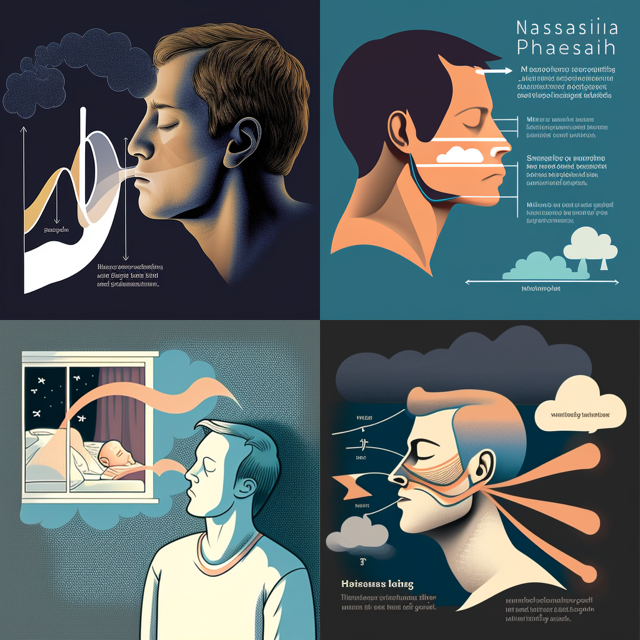





So, what does the future hold?
Ultimately, AI will become an essential part of the creative process. It will help us to produce better work faster and more efficiently, while freeing up time for us to focus on the things that really matter — creativity and innovation. So the next time you’re working on a project, don’t be afraid to embrace the power of artificial intelligence. It’s here to stay.
At this point, you’re probably in one of two camps:
- You’re convinced that AI is going to change everything.
- You’re still weirded out by the burger covered in mold.
No matter which camp you’re in…
It’s important to know that as a marketer, artificial intelligence isn’t something that you should be afraid of. Tools like Jasper, Midjourney, and even the AI Google Sheets tool created by Arielle Phoenix are just that… tools. But these tools come with great power, and as Stan Lee once wrote:
“With great power comes great responsibility.”
It’s on us to use AI tools appropriately.
These tools will arm you with the ability to do things that the early professionals of our industry couldn’t even imagine as a possibility. Technologies like this come only a few times in a century.
And in this moment, we all have an opportunity to capture something special. We can take part in what I believe will be the next great technological revolution in our industry. It’s going to be messy. It’s going to be chaotic. And it’s going to come with a lot of pushback from a lot of different actors, ranging from government to industry.
But even then… I’m confident that this is going to change everything.
Agree? Disagree?
I’d love to hear your take.







